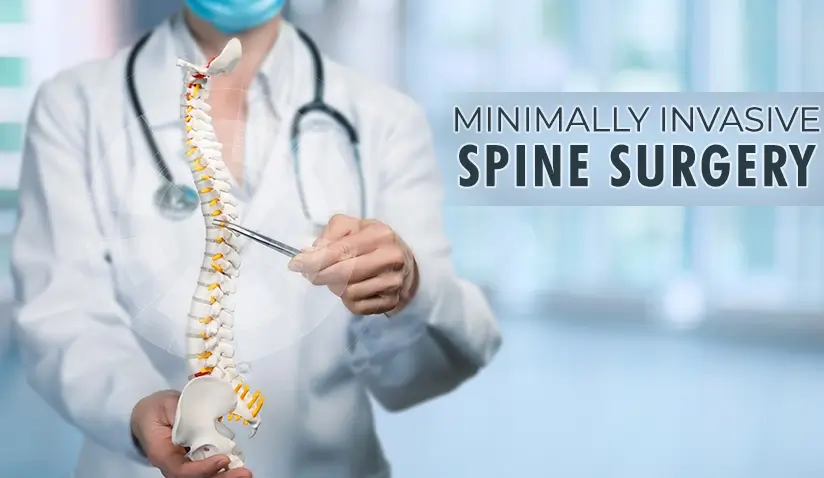Minimally Invasive Spine Surgery: Advanced Techniques and Conditions Treated

Understanding Minimally Invasive Spine Surgery (MISS)
Comparing MISS to Traditional Open Surgery
Spinal issues affect millions of people worldwide, with studies showing that up to 80% of adults will experience some form of back pain during their lives. Traditional spinal surgeries, while effective, often come with significant drawbacks, including long recovery times, substantial pain, and increased risks of complications.
This article covers minimally invasive spine surgery, the conditions treated, success rates, advanced techniques, and much more.
Understanding Minimally Invasive Spine Surgery (MISS)
The core concept of MISS is to achieve the same surgical goals as traditional open surgery but with much less physical impact on the body.
This is accomplished by utilizing smaller incisions, specialized tools, and advanced imaging techniques to guide the surgeon precisely during the procedure. These advancements result in less tissue damage, reduced blood loss, and quicker recovery.
What Happens During the Surgery?
During minimally invasive spinal surgery, the surgeon makes a series of small incisions instead of one large one. Through these incisions, specialized instruments and a tubular retractor are inserted to create a small working channel.
Advanced imaging modalities, such as fluoroscopy or endoscopy, guide the surgeon in real-time, ensuring precise movements and minimizing damage to surrounding tissues. Depending on the condition treated, the surgeon may remove herniated disc material, decompress nerve roots, or stabilize the spine using screws and rods.
Is Minimally Invasive Spine Surgery Painful?
One of the significant advantages of MISS is that it is generally less painful than traditional open spine surgery. The smaller incisions and reduced muscle dissection result in less trauma to the body, which typically leads to less post-operative pain. Most patients report manageable discomfort that can be effectively controlled with medications and tends to resolve more quickly.
Does Minimally Invasive Spine Surgery Require General Anesthesia?
The choice of anesthesia is ascertained by the surgeon and anesthesiologist, considering what is safest and most effective for the individual patient. While most minimally invasive spine surgeries are performed under general anesthesia, some procedures can be performed with regional anesthesia or sedation.
Comparing MISS to Traditional Open Spine Surgery
Minimally invasive spine surgery has several evident benefits over traditional open surgery, such as:
- Smaller Incisions and Less Tissue Damage
- Reduced Blood Loss and Quicker Recovery Times
- Reduced Risk of Complications
- Less Post-Operative Pain and Faster Return to Function
- Improved Cosmetic Outcomes with Minimal Scarring
Conditions Treated with Minimally Invasive Spine Surgery
Minimally invasive spine surgery is gaining traction as an effective treatment option for various spinal conditions, providing pain relief and enhanced quality of life for many patients. Here are some of the primary conditions that can be treated with MISS:
- Herniated Discs: Occur when a spinal disc's outer layer ruptures, causing the soft inner material to bulge out. This condition can cause significant pain, numbness, and weakness.
- Spinal Stenosis: Occurs when spaces within the spinal canal become narrow, which can compress the nerves and cause pain, tingling, and muscle weakness.
- Degenerative Disc Disease: Characterized by the intervertebral discs losing their cushioning ability, leading to pain and reduced mobility.
- Spinal Fractures and Vertebral Compression Fractures: Can be caused by trauma or osteoporosis.
- Spinal Deformity: Such as scoliosis (a lateral curvature of the spine) and kyphosis (an excessive outward curvature of the spine).
- Spinal Instability, including Spondylolisthesis or Pars Defect: Where a vertebra in the lower back slips out of place relative to the adjacent vertebra, which can cause significant pain and neurological symptoms.
- Spinal Tumors: Abnormal (benign or malignant) growths of cells that develop within or around the spinal cord and spinal column.
- Spinal Infections: A rare but serious condition caused by an invasion of bacteria, fungi, or viruses into the tissues of the spine.
- Facet Joint Pain: Pain occurring in the small joints at each spinal segment that provide stability and allow for motion.
Minimally Invasive Spine Surgery Procedures
Minimally Invasive Discectomy
A procedure to remove a herniated disc pressing on a nerve, which may potentially be followed up with disc replacement by inserting an artificial disc to maintain spinal mobility. It can take 1-2 hours and offers high success rates (80-95% pain relief) depending on the technique used. Microdiscectomy, endoscopic discectomy, and percutaneous discectomy are all variations of minimally invasive discectomy employing different access methods, i.e., using microscopic guidance, an endoscope through a small incision, or a needle and special instruments.
- Conditions Treated: Herniated discs, degenerative disc disease.
- Recovery: Typically requires a short hospital stay (1-2 days) depending on the approach; some allow for outpatient procedures. Recovery generally involves physical therapy and activity modification, with some methods allowing faster return to light activities.
- Potential Complications/Side Effects: Potential complications include infection, nerve damage, and disc reherniation, though the risk may vary depending on the specific approach used.
Minimally Invasive Lumbar Discectomy (MILD) is a form of discectomy focusing on reducing tissue damage in the lumbar spine.
Laminectomy/Laminotomy
Removal (laminectomy) or partial removal (laminotomy) of a vertebral bone (lamina) to relieve spinal cord or nerve root compression. It can take 1-3 hours, providing significant symptom relief in most patients.
- Conditions Treated: Spinal stenosis, herniated discs.
- Recovery: Hospital stay of 1-3 days. Physical therapy is typically necessary.
- Potential Complications/Side Effects: Infection, nerve damage, spinal instability.
Laminoplasty
Involves reshaping or repositioning the lamina to expand the spinal canal. The 2-3 hour procedure can substantially improve symptoms in most cases.
- Conditions Treated: Cervical spinal stenosis.
- Recovery: Hospital stay of 2-4 days. Physical therapy and activity modification are crucial.
- Potential Complications/Side Effects: Nerve injury, infection, reduced neck motion.
Foraminotomy
This widens the foramen (nerve root opening) to relieve nerve compression. Typically taking 1-2 hours, the procedure offers significant symptom relief for most patients.
- Conditions Treated: Spinal stenosis, herniated discs.
- Recovery: Short hospital stay or outpatient procedure. Physical therapy is recommended.
- Potential Complications/Side Effects: Infection, nerve damage, spinal instability.
Kyphoplasty and Vertebroplasty
Both procedures stabilize compression fractures in the spine by injecting bone cement. Kyphoplasty additionally involves creating a working space by inflating a balloon-like device in the bone. The 1-2 hour procedure significantly reduces pain in 85-90% of patients.
- Recovery: Outpatient or short hospital stay. Quick return to normal activities.
- Potential Complications/Side Effects: Cement leakage, infection, adjacent vertebral fractures.
Minimally Invasive Direct Pars Repair (MID-PR)
Repairs defects in the pars interarticularis, a small bridge of bone in your spine that connects facet joints for stability. This 1-2 hour procedure has a high success rate for pain relief and function.
- Conditions Treated: Pars defect, spondylolysis.
- Recovery: Hospital stay of 1-2 days. Physical therapy is crucial.
- Potential Complications/Side Effects: Infection, nerve damage, recurrence of the defect.
Percutaneous Treatment of Spinal Disc Disease
Uses a needle and special instruments to treat disc herniation and degeneration. This approach typically takes 30-60 minutes and offers high success rates for pain relief and function.
- Conditions Treated: Herniated discs, degenerative disc disease.
- Recovery: Outpatient procedure. Rapid recovery with minimal restrictions.
- Potential Complications/Side Effects: Infection, nerve damage, recurrence of disc problems.
While not classified as surgical procedures, facet joint and intradiscal injections are a minimally invasive option for treating facet joint or disc inflammation and pain by injecting steroids or other medications. These are 15-30 minute outpatient procedures that have varying success rates but can offer significant temporary pain relief and enable a rapid return to normal activities.
Advanced Techniques/Technology Used in Minimally Invasive Spine Surgery
Here are some of the key advanced techniques and technologies used in MISS:
Endoscopic Spine Surgery
Endoscopic spine surgery utilizes an endoscope — a small, flexible tube with a camera and light at the end — and specialized instruments to perform spinal surgery through tiny incisions. The procedure takes 1-2 hours and has a high success rate for symptom relief.
- Conditions Treated: Herniated discs, spinal stenosis, degenerative disc disease.
- Recovery: Typically outpatient with quick recovery. Patients often return to normal activities within a few weeks.
- Potential Complications/Side Effects: Infection, nerve damage, recurrence of the condition.
Endoscopic Transforaminal Lumbar Discectomy (ETLD) is a subtype of this technique used to remove a herniated disc in the lower back through the foramen. It can sometimes be combined with Artificial Disc Replacement.
Ultra Minimally Invasive Spine Surgery (uMISS)
uMISS is a refinement of minimally invasive endoscopic surgery, utilizing even smaller incisions and more specialized tools. This technique takes 1-2 hours to perform and aims to reduce recovery times further while improving surgical outcomes. Success rates have shown promise with many patients experiencing rapid recovery and significant symptom relief.
- Conditions Treated: Similar to endoscopic spine surgery but with less tissue disruption.
- Recovery: Often faster than standard minimally invasive procedures. Outpatient or short hospital stay.
- Potential Complications/Side Effects: Similar to other minimally invasive techniques, but potentially lower due to less invasiveness.
Minimally Invasive Fusion Surgery
This involves stabilizing the spine by fusing two or more vertebrae through small incisions using specialized instruments. The procedure takes 3-4 hours and has high success rates, offering pain relief and improved stability.
- Conditions Treated: Spinal instability, degenerative disc disease, spondylolisthesis.
- Recovery: Hospital stay of 2-4 days. Physical therapy is essential for recovery.
- Potential Complications/Side Effects: Infection, nerve damage, non-union of the fusion.
Transforaminal Lumbar Interbody Fusion (TLIF) is a specific type of lumbar fusion surgery (can be minimally invasive or open) where an interbody device is placed through the foramen to provide added stability.
Microsurgery
Microsurgery involves using a surgical microscope to perform delicate and precise spinal procedures through small incisions. It usually takes 1-2 hours and has a high success rate for symptom relief.
- Conditions Treated: Herniated discs, spinal stenosis, nerve root compression.
- Recovery: Typically outpatient or short hospital stay. Quick return to normal activities.
- Potential Complications/Side Effects: Infection, nerve damage, recurrence of the condition.
Laser Surgery
Lasers enable precise tissue ablation or disc decompression, reducing the need for traditional surgical tools. The procedure takes 30-60 minutes. Success rates are variable, yet many experience significant pain relief.
- Conditions Treated: Herniated discs, spinal stenosis.
- Recovery: Outpatient procedure with minimal recovery time. Patients often resume activities quickly.
- Potential Complications/Side Effects: Infection, nerve damage, incomplete decompression.
Robotic-Assisted Surgery
Robotic systems enable enhanced precision and control, allowing for greater accuracy. Surgery typically takes 2-4 hours and can improve outcomes and reduce recovery times.
- Conditions Treated: Various spinal conditions, including herniated discs, spinal stenosis, and spinal instability.
- Recovery: Short hospital stay. Quick recovery with physical therapy.
- Potential Complications/Side Effects: Infection, nerve damage, mechanical malfunction (extremely rare).
Minimally Disruptive Implants and Biologics
Implant placement with minimal tissue disruption and the use of biologics promote healing and fusion. Procedure durations range from 2 to 4 hours and can lead to significant symptom relief and improved spinal stability.
- Conditions Treated: Spinal instability, degenerative disc disease, spondylolisthesis.
- Recovery: Short hospital stay. Physical therapy and activity modification are essential.
- Potential Complications/Side Effects: Infection, hardware failure, non-union.
Augmented Reality (AR) Technology
AR technology provides enhanced visualization, improving precision and outcomes while reducing the risk of complications. This approach can take 2-4 hours.
O-arm Navigation
O-arm navigation provides real-time 3D imaging, allowing for precise placement of implants and instruments and improved surgical outcomes. The process takes 2-4 hours.
Who is a Candidate for Minimally Invasive Spine Surgery?
The decision involves careful evaluation of several individual factors.
It is essential to consult a spine surgeon who will assess:
- Overall Health: Candidates should ideally be in good health, without severe comorbid conditions that could complicate surgery or recovery, such as uncontrolled diabetes, severe heart disease, or severe respiratory issues.
- Severity of the Spinal Condition: MISS is often suitable for conditions like herniated discs, spinal stenosis, degenerative disc disease, and spinal instability. However, more complex conditions might require traditional open surgery, which a spine specialist would factor in.
- Anatomical Suitability for MISS Techniques: The patient’s spinal anatomy must be suitable for MISS techniques. This includes considerations like the size and location of the spinal issue, as well as the overall structure of the spine.
Who is Not a Candidate for Minimally Invasive Spine Surgery?
Certain factors may disqualify a patient from being a candidate for MISS:
- Age Limit: While there is no strict age limit, older patients with significant comorbidities may not be ideal candidates due to higher surgical risks.
- Disqualifying Conditions: Patients with severe osteoporosis, extensive spinal deformities such as severe scoliosis or kyphosis, advanced spinal tumors, or widespread spinal infections may not be suitable for MISS. These conditions require extensive reconstruction and necessitate traditional open surgery.
- Specific Anatomical Constraints: Some patients’ spinal anatomies may not be compatible with MISS techniques. This includes individuals with very large or complex herniations or those with anatomical variations that make minimally invasive access difficult or unsafe.
Importance of Individual Evaluation
Each patient’s condition is unique, and individual evaluation is critical. A spine surgeon will conduct thorough assessments, including imaging studies like MRI or CT scans, to determine the best surgical approach. Personalized evaluation ensures that the chosen technique is safe and effective depending on the patient’s specific needs, maximizing the benefits of the surgery while minimizing risks.
Recovering from Minimally Invasive Spine Surgery
Minimally Invasive Spine Surgery offers numerous benefits, particularly in terms of recovery. Here’s what to expect during the recovery period:
Shorter hospital stay: Many MISS procedures are outpatient, allowing same-day discharge or a short stay.
Physical therapy: Crucial for recovery, helps restore mobility and strengthen muscles around the spine. Patients usually progress gradually from gentle exercises to more intense rehabilitation programs.
Pain management: Medications manage post-operative pain, which is often less severe due to smaller incisions and reduced tissue damage.
Following your doctor’s instructions, such as taking prescribed medications, adhering to activity restrictions, and attending follow-up appointments, is crucial for optimal healing.
Disadvantages of Minimally Invasive Spine Surgery
While MISS has many advantages, it also comes with potential disadvantages and risks:
- Excess Bleeding: Although less common in MISS due to smaller incisions, bleeding can still occur during or after surgery.
- Pain at the Graft Site: If bone grafts are used, patients may experience pain at the graft site.
- Blood Clots: Formation of blood clots (deep vein thrombosis) is a potential risk, although less likely than in more invasive surgeries.
- Leaking of Spinal Fluid: Dural tears can lead to spinal fluid leaks, which may require additional treatment or surgery.
The drawbacks of specific procedures are outlined above.
Conclusion
Minimally invasive spine surgery is undergoing significant advancements in technology, techniques, and materials used.
These developments hold promise for:
Treating a broader range of spinal conditions: MISS may become applicable to more complex spinal issues, potentially reducing the reliance on traditional open surgeries.
Improved fusion outcomes: New techniques and implants aim to enhance fusion success rates while minimizing recovery times.
Outpatient MISS procedures: As MISS evolves, select procedures may be performed on an outpatient basis, enabling faster recovery at home and potentially reducing healthcare costs.
Overall, these advancements paint a promising future for spine surgery. Patients may benefit from a wider range of minimally invasive treatment options, leading to faster and more comfortable recovery experiences.

Dr. Gerardo Conesa Bertrán is the Chief of Neurosurgery and Director of the Teknon Neuroscience Institute at QS Teknon Medical Center, Barcelona. Dr. Conesa offers extensive expertise in minimally invasive spinal surgery for spinal tumor removal and epilepsy surgery in adults and children. He is also specialized in awake brain surgery of highly functional areas with more than 700 cases performed.
With over 30 years of extensive experience in Neurosurgery, Dr. Conesa has won several awards in recognition of his professional and research career.

Teknon’s neurosurgery center in Barcelona is one of the top brain surgery referral centers in Spain and Europe. Led by Dr. Gerardo Conesa Bertrán, our doctors have vast experience in performing advanced brain imaging and mapping to give their patients the best neurological outcomes from open brain surgery.
Teknon's brain surgery team runs one of the top specialized neurosurgery referral centers in Europe. Our surgeons, neurologists, anesthetists, and therapists have extensive experience in awake brain surgery using the safest and most advanced brain mapping techniques.
For more details, please visit https://www.quironsalud-hospitals.com/
References:
Featured Blogs



